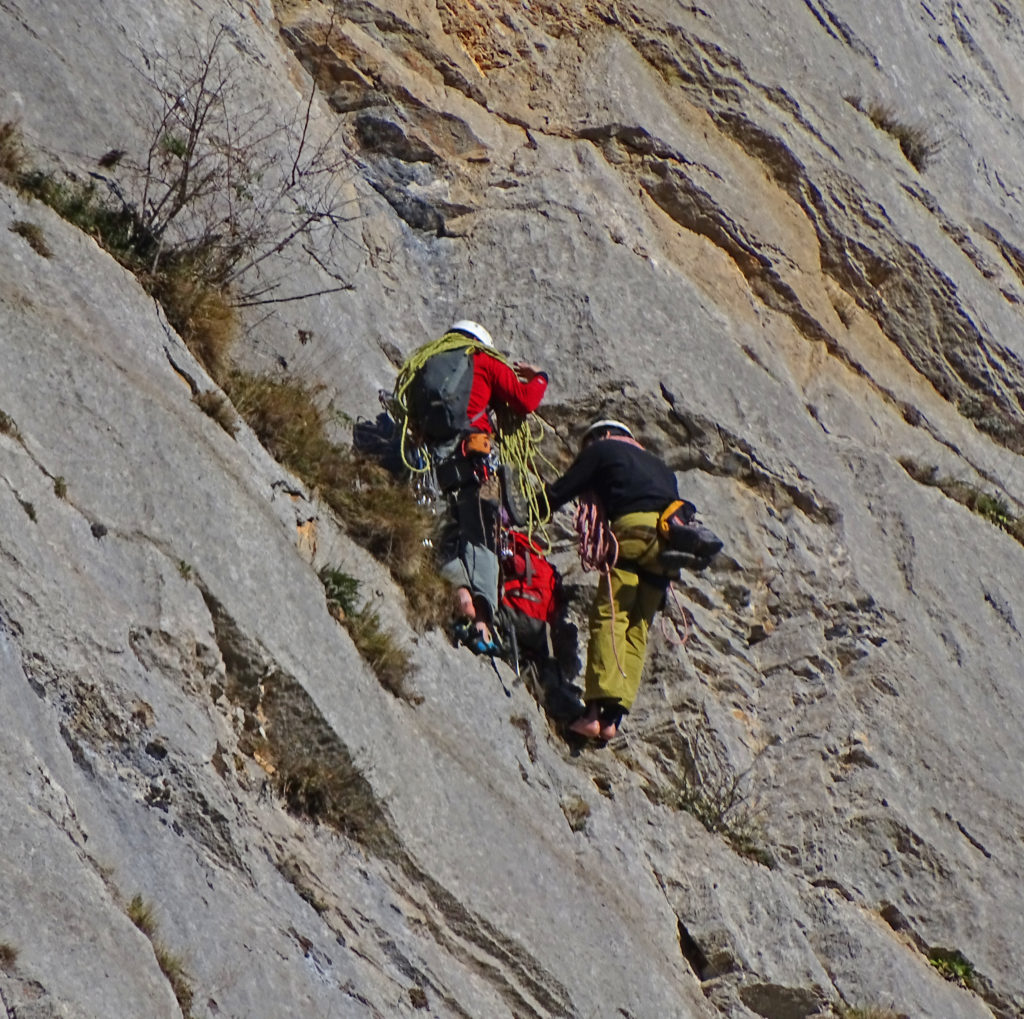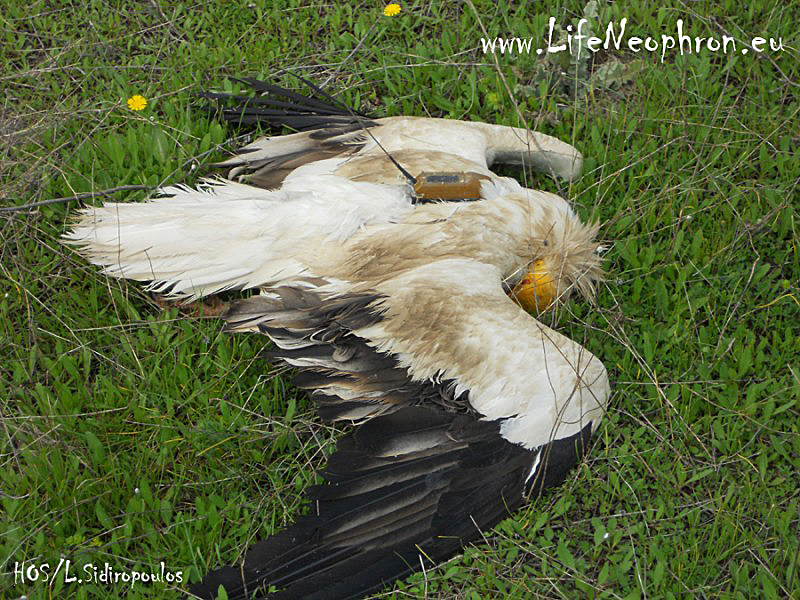Anthropic disturbance
The Egyptian vulture is a species which is very sensitive to anthropic disturbance, which means that various activities carried out near the nesting sites can result in abandonment of the nests and the failure of reproduction. Without even realising, hikers, photographers and ornithologists can cause irreparable damage to a species that is incredibly precious, simply with their presence or due to their curiosity or their compulsive impulse to take photos.
Not to mention activities such as climbing, which, in addition to compromising nesting, significantly reduces the availability of peaceful and suitable breeding sites for the species.

Poison
The use of poison bait is illegal, but it is nevertheless rife and one of the most widespread and most serious threats to the conservation of the Egyptian vulture throughout its European area. Poison is used for various reasons. Frequently it is used to get rid of animals such as wolves, foxes and feral or stray dogs, which can prey on livestock or species of hunting interest. In Italy, poison baits are frequently used in truffle hunting areas, subject to disputes between truffle gathers and between truffle gathers and hunters. In the Canary Islands poison is used to kill animals that can damage certain crops, such as lizards, which bite into tomatoes, grapes and strawberries to quench their thirst.
The poison strikes in a non-selective way, meaning that many species of necrophagous birds (vultures, red kites, golden eagles, Iberian imperial eagles, eastern imperial eagles, etc.) end up being “collateral” victims. These can be killed when they feed on poison bait scattered on the ground or on the carcasses of dead poisoned animals.
It has been established in Spain, for example, that 69 vultures died from the ingestion of poison between 2005 and 2010.
In the Balkans, the practice of using poison is particularly virulent, and serious episodes of poisoning have occurred for years: In 1993, as many as 62 vultures died from being poisoned in a waste dump in a village in Macedonia; whilst in 2003, another seven Egyptian vultures died from the same cause in the eastern part of the Rhodope Mountains. Currently, given the progressive numeric decline of the Egyptian vulture, poison continues claim victims – mainly the Griffon vulture.
Lastly, it must be highlighted that unnecessary de-ratting campaigns carried out in landfills may be a serious threat to the Egyptian vulture.
Electrocution
The Egyptian vulture is susceptible to electrocution, especially in areas where there are few trees for them to rest and spend the night. Cases of mortality caused by power lines are known in Europe but also in wintering areas such as Ethiopia and Sudan.
In the Canary Islands, power lines have been responsible for a further major mortality factor for the species, namely the “hooking” phenomenon: The vultures get trapped in anti-vibration devices in the upper part of the power line supports (installed due to strong winds that may occur) and then die hanging there. A LIFE project implemented some years ago (LIFE Guirre) approved the implementation of technical modifications which completely eliminated this dangerous risk.
Poaching in Europe
Poaching in Europe is a threat which is present everywhere, and hard to quantify. Poaching is considered the primary cause behind the rapid and substantial numerical collapse of the Egyptian vulture population that occurred in the 20th century and still seems a significant negative factor, especially in certain rest areas during migration (e.g. in the Province of Trapani, Italy).
Migration
Migration is a time of extreme vulnerability, both for vultures from Eastern Europe and for the Egyptian vulture population in Italy. This is because the juveniles, who are facing the journey for the first time, are exposed en-route to many natural anthropic threats, but also because it forces the inexperienced birds to face an extremely subtle and dangerous pitfall: Crossing the Mediterranean Sea to reach Africa.
For the Italian population of Egyptian vultures, the Mediterranean Sea is a very large obstacle and crossing it can be lethal if juveniles do not take the “right” route, which is the one that passes through western Sicily and leads them to Tunisia by crossing “only” 150 km of open sea.
Unfortunately, the numerical scarcity of the Italian population means that there are few subadults or adults who, having already travelled that specific migration route, can act as a guide for the juveniles. The risk of juveniles venturing into the open sea once they arrive in southern Sicily, finding themselves before an interminable crossing (over 500 km of open sea) with an uncertain outcome – probably death – is therefore huge.
Habitat changes
The Egyptian vulture prefers open areas in which extensive agro-pastoral activities are carried out; the destruction of these environments or their transformation into intensively cultivated areas (olive groves, vineyards, etc.) reduces the trophic availability for the species.
This situation is aggravated as health standards generally prevent the carcasses of livestock from being left on the ground, at the disposal of the necrophagous fauna.
In Spain, for example, the Egyptian vulture has been adversely affected by the closure of many landfills and places where breeders used to dispose of dead cattle, called muladares or vertederos; The lower availability of food linked to the demographic decline of the wild rabbit has further aggravated this situation.
Lead poisoning
Like many other species of birds of prey, the vulture is affected by the problem of lead poisoning caused by the ingestion of carcasses containing residues of this heavy metal. Although the impact that this problem has on the various populations in terms of conservation (effect on fitness, productivity, mortality, etc.) is unknown, in Spain and Greece numerous vulture deaths due to lead ingestion are known.
Wind farms
The presence of wind farms is a significant risk factor for the species: Impact against the rotating blades of these gigantic structures is a well-known cause of death of numerous species of birds of prey. Regrettably, in Spain and Italy wind farms have also been constructed along the main migratory routes to Africa.
African areas of migration and wintering
Unfortunately, the African transit and wintering areas of the species, especially those between Niger, Sudan and Nigeria, are extremely dangerous for the Egyptian vulture due to the sharp increase in poaching and the use of the poison produced to kill cattle predators. Cases of vultures killed to be eaten are also known.
Sadly, many of the Egyptian vultures born in the Balkans and those born in captivity and released in Italy in recent years have not returned from the African continent.


